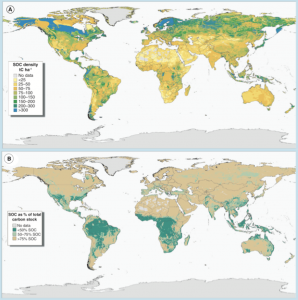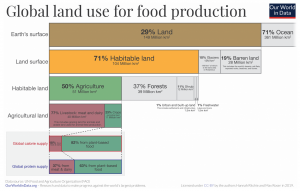Paulina Körner
The majority of terrestrial carbon is stored in the soil. Scientists have found that land use change and rising temperatures will increase the net loss of soil carbon to the atmosphere, which could accelerate climate change. A new land management approach is needed to keep the carbon in the soil and potentially even use it as a carbon sink.
The importance of soil carbon
Scientists agree that land-use and land cover change (LULCC) is the second largest anthropogenic source of carbon emissions into the atmosphere right after emissions from fossil fuel combustion (Scharlemann et al. 2014). Thus far, climate change mitigation policies have mostly been focused on carbon stored in phytomass (biomass carbon), neglecting that soils and surface litter store two to three times as much carbon in organic form as there is carbon in the atmosphere (Scharlemann et al. 2014). Currently, there are considerable uncertainties in the understanding of carbon stocks, the geographic variation, and the potential impacts of land use and land cover change on carbon stocks. Nevertheless, there are indications that global warming could stimulate the loss of carbon into the atmosphere, which then could drive a land-carbon-climate feedback that could accelerate climate change. However, at present, Earth System Models are unable to calculate the influence of climate change, land use, and land cover change on soil organic carbon stocks (SOC) and soil carbon dynamics accurately (Scharlemann et al. 2014). To fully understand the consequences and feedback loops of global warming and to develop carbon emissions targets that are compatible with specific climate change scenarios, it is crucial that we better understand soil carbon stocks.
Soil carbon can either be stored as soil organic carbon (SOC) or inorganic carbon. SOC is carbon derived from decaying vegetation, fungal and bacterial growth and activities of living organisms. There is a wide variation in estimates of global SOC stocks due to differences in the sampling period, intensity, and approaches to calculations. However, most studies find a comprehensive SOC estimate of roughly 1500 billion tons of carbon worldwide. Most of the SOC is stored in northern latitudes, especially in permafrost regions. In contrast, the most abundant quantities of phytomass carbon have been observed in wet and moist tropical forests near the equator (Scharlemann et al. 2014). SOC accounts for the majority of total carbon stocks in over 60% of the global land area (See Figure 1). Especially in those areas, climate change mitigation efforts are necessary to promote land-use practices that keep the carbon in the ground or even stimulate carbon sequestration. On 18% of the global land area, SOC constitutes less than 50% of combined carbon stock. In these areas, land use that preserves phytomass carbon is more efficient in reducing emissions (Scharlemann et al. 2014).

Figure 1: Global distribution of carbon density (tons of C ha-1). (A) Soil organic carbon to 1 m depth; (B) SOC as a percentage of total carbon stocks in soil and phytomass; Source: (Scharlemann et al. 2014)
The role of agriculture
Agriculture plays a crucial role in maintaining and increasing soil organic carbon. 29% percent of Earth’s surface consists of land, of which 71% is habitable land. Currently, 50% of this area is used for agriculture (Ritchie und Roser 2020).

Figure 2: Global land use for food production; Source: (Ritchie und Roser 2020)
Agriculture has long-lasting consequences for soils and ecosystems. Agricultural cultivation of land usually causes a rapid loss of SOC. Following the initial implementation of farming, the loss of soil organic carbon continues for several decades. On average, the SOC stocks are reduced to 70% of the levels before agricultural usage. When SOC levels reach a new equilibrium, the rate of loss decelerates (McLauchlan 2006).
Several agricultural practices influence SOC stocks. Compared to perennial native vegetation, harvesting annual crops reduces the amount of carbon inputs to the soil. The carbon content of annual crops may also differ from the carbon quality in native vegetation. Furthermore, tillage increases soil organic carbon decomposition rates and destroys soil aggregates and the physical soil structure. Previously physically protected SOC becomes exposed to decomposition. Tillage and the lack of plant cover also expose soil to erosion by water and wind, which leads to the loss of SOC (McLauchlan 2006).
However, management approaches in agricultural systems also have huge potential to limit or mitigate SOC losses. Such management approaches include manuring and fertilizing, no-tillage, conversation tillage, reduced tillage, management of crop residues, and cover cropping. It is also possible to increase SOC through agroforestry, application of biochar, perennial crops, reforestation, and afforestation (Scharlemann et al. 2014).
Soil C sequestration (SCS)
According to the International Panel on Climate Change (IPCC), air temperatures have already risen by about 1°C. To limit the warming to 1.5°C, the utilization of carbon dioxide removal (CDR) or negative CO2 emissions technologies will be necessary. Such technologies can either follow a biological approach or a technical approach. Amongst others, Soil carbon sequestration (SCS) is a biological approach to sequester carbon. SCS is defined as the increase in soil carbon content and, therefore, net uptake of CO2 due to changes in land management (Keel et al. 2019). It has been estimated that in the top 1 m of agricultural soils, one-third of global anthropogenic greenhouse gas emissions could be sequestered (Budiman Minasny et al. o. J.). The amount of organic carbon stored in the soil depends on several factors. The balance of carbon inputs and losses determines whether a soil emits or sequesters carbon. Therefore, carbon sequestration can either be achieved through increasing carbon inputs or by reducing the losses. Many different practices to improve SCS have been discovered, but whether they are suitable or not is side-specific.
Due to the large potential of SCS the international “4 per mille Soils for Food Security and Climate” initiative was launched at the Paris Climate Conference in 2015 to increase global soil organic matter stocks by 4 per 1000 (or 0.4 %) per year as a compensation for the global emissions of greenhouse gases by anthropogenic sources. The value of 0.4°C resulted from a simple calculation: Annual greenhouse gas emissions from fossil carbon are estimated to be 8.9 gigatonnes C and the global estimated soil carbon stock in 2 m of soil depth is 2400 gigatonnes. The ratio of these two values equals 0.4% (8.9/2400*100=0,4%). The initiative was supported by almost 150 stakeholders, including countries, regions, international agencies, private sectors, and NGOs. The signatories agreed to a voluntary action plan to apply farming practices that maintain or enhance soil carbon stocks in agricultural soils and to preserve carbon-rich soils. It has been shown that 4 per mille or even more can be achieved when best management practices are applied. If the initial SOC stock is low, high carbon sequestration rates of up to 10 per mille can be reached during the first twenty years after the implementation of best management practices. Therefore, soil C sequestration could be a strategy for climate change mitigation that could buy time over the next ten to twenty years until other carbon sequestration and low carbon technologies become feasible (Budiman Minasny et al. o. J., 4).
Soil carbon management does not only have the potential to improve climate regulation but can also affect other ecosystem services. An increase in carbon content in the soil can increase water and nutrient storage, can promote greater resistance to erosion and climate extremes, and can even lead to higher productivity in soils in which SOC has previously been low (Keel et al. 2019).
However, soil carbon sequestration also has some downsides. The most significant disadvantage is that SCS can be reversed, if soil management practices are not maintained. Furthermore, at one point, soils reach carbon saturation and SOC stocks tend to equilibrate, which makes soil carbon sequestration finite (Keel et al. 2019). Some soil carbon sequestration approaches can even increase emissions of other greenhouse gas emissions. For example, increasing carbon stocks in peatlands can increase the risk of acidification, methane, and nitrous oxide emissions (Scharlemann et al. 2014).
Conclusion
Two to three times more carbon is stored in the soil than in the atmosphere. This scale provides the opportunity to significantly decrease atmospheric carbon dioxide with a relatively small increase in soil carbon stocks. It is hard to understand why this topic hasn’t gotten more attention in the debate about how to mitigate climate change and why more research hasn’t been done in this field. There is still a lot of uncertainty concerning the role of soil carbon in the global carbon cycle. Until now, soil carbon hasn’t been included in most climate models and more information is needed in order to include it in the calculations. We are just beginning to understand the temperature sensitivity of soil carbon stocks. However, everything we do now indicates that soil carbon sequestration could be a crucial aspect in order to mitigate climate change. Soil carbon has the potential to either become a vital tool in decreasing the carbon dioxide concentration in the atmosphere or dramatically speed up global warming. We have the choice.
Sources
Budiman Minasny, Brendan P. Malone, Denis A. Angers, und Alex P. McBratney. o. J. „Soil Carbon 4 per Mille“. Zugegriffen 20. April 2020. https://doi.org/10.1016/j.geoderma.2017.01.002.
Keel, Sonja G., Thomas Anken, Lucie Büchi, Andreas Chervet, Andreas Fliessbach, René Flisch, Olivier Huguenin-Elie, et al. 2019. „Loss of Soil Organic Carbon in Swiss Long-Term Agricultural Experiments over a Wide Range of Management Practices“. Agriculture, Ecosystems & Environment 286 (Dezember): 106654. https://doi.org/10.1016/j.agee.2019.106654.
McLauchlan, Kendra. 2006. „The Nature and Longevity of Agricultural Impacts on Soil Carbon and Nutrients: A Review“. Ecosystems 9 (8): 1364–82. https://doi.org/10.1007/s10021-005-0135-1.
Ritchie, Hannah, und Max Roser. 2020. „Environmental impacts of food production“. Our World in Data, Januar. https://ourworldindata.org/environmental-impacts-of-food.
Scharlemann, Jörn PW, Edmund VJ Tanner, Roland Hiederer, und Valerie Kapos. 2014. „Global soil carbon: understanding and managing the largest terrestrial carbon pool“. Carbon Management 5 (1): 81–91. https://doi.org/10.4155/cmt.13.77.
Media Attributions
- Global distribution of carbon density
- Global land use for food production